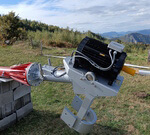Vaisala and WindSim Complete Largest-Ever Validation of Remote Sensing in Complex Terrain
Vaisala, a global leader in environmental and industrial measurement, has collaborated with WindSim, a pioneer in computational fluid dynamics (CFD) modelling, on a study that demonstrates how the effects of complex terrain on wind measurements collected by remote sensing units can be mitigated. The collaboration has included the most extensive complex terrain validation of remote sensing data undertaken in the wind energy sector to date. The results establish a methodology for considerably reducing the uncertainty of data collected by the Triton Wind Profiler in complex terrain, opening the door to more effective measurement campaigns in areas of untapped resource.
For wind energy developers prospecting at more challenging, off-grid sites - such as on ridge lines, hillsides and in heavily forested areas - the versatility, maneuverability and size of remote sensing devices means that they offer numerous potential advantages over met towers. Validating the accuracy of a remote sensing system in complex terrain removes one of the few remaining barriers to the widespread adoption of the technology across the industry.
"While remote sensing devices are increasingly supplanting met towers as the preferred technology for wind measurement campaigns, concerns over the way both SoDAR and LiDAR technologies respond to complex air flows have posed an obstacle," said Pascal Storck, Director of Renewable Energy at Vaisala. "Our study with WindSim shows how topographical factors can reliably be accounted for."
An unprecedented global collocation study
Independent R&D efforts continue to set the standard for wind measurement practices worldwide. Increasingly, advanced CFD methodologies are being used by respected companies such as WindSim to evaluate how remote sensing units respond to wind flow in complex terrain, in order to determine where corrections to wind estimates can be made.
This is not required in areas where the ground is relatively flat and the flow field is uniform, but in complex terrain, this flow field can be disrupted, introducing a bias into the measured wind speeds.
Vaisala's extensive complex terrain validation study spanned 20 individual sites, each with a collocated Triton Wind Profiler and met mast, collecting simultaneous measurements for a period of 1-4 months. These sites were distributed across the globe and exhibited a variety of local terrain complexity.
Using publicly available elevation and land cover data, WindSim configured CFD simulation domains surrounding each collocation site and conducted simulations for a variety of inflow conditions. From these simulations, Vaisala developed correction factors to account for wind flow curvature, for each measurement height and wind direction sector.
By applying these CFD-based corrections to Triton data, Vaisala found a reduction in the mean wind speed difference between the Tritons and met towers - from -1.7% to -0.1% - and in the standard deviation - from 2.5% to 2.1%. The correction therefore not only eliminated the overall bias, but also reduced the spread of error among the sites.
A reliable, repeatable methodology
"The accuracy of remote sensing data has widely been recognized as on a par with that of met towers in all aspects - except when it comes to operating in complex terrain," said Dr. Arne Gravdahl, WindSim Founder and Chief Technical Officer. "Using CFD simulations to adjust Triton data removes this concern, levelling the playing field in terms of data quality, and allowing developers to take full advantage of the Triton's versatility."
"Our study shows that it's a reliable, repeatable methodology, and we're looking forward to seeing the impact it has for Vaisala's clients as they pioneer wind development in those parts of the world where the best resource isn't always on flat terrain."
Click here to view the full results of the complex terrain validation study.
The issue of complex terrain and the validation of wind measurement data is further discussed in Vaisala's Remote Sensing Revolution report, which brings together perspectives from across the wind energy sector, encompassing developers, operators, financiers and consultants. If you would like to download a copy of the report, please click here.
- Source:
- Vaisala
- Author:
- Press Office
- Link:
- www.vaisala.com/...
- Keywords:
- Vaisala, WindSim, study, remote sensing, measurement

























